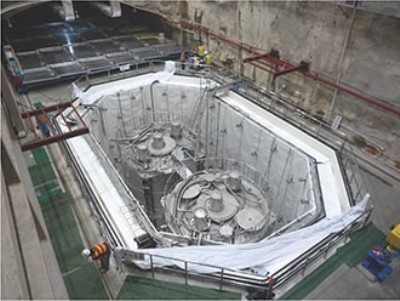As the first step of Daya Bay experiment, a pair of antineutrino detectors has been installed in three experimental halls. Currently, these detectors are recording interactions of elementary particles known as antineutrinos that are generated by potent reactors located at the China Guangdong Nuclear Power Group’s power facility near Hong Kong.
 Twin detectors recently installed in the Daya Bay Reactor Neutrino Experiment, shown here earlier this summer, are now recording interactions of elementary particles called antineutrinos produced by powerful reactors at the China Guangdong Nuclear Power Group power plant in southern China.
Twin detectors recently installed in the Daya Bay Reactor Neutrino Experiment, shown here earlier this summer, are now recording interactions of elementary particles called antineutrinos produced by powerful reactors at the China Guangdong Nuclear Power Group power plant in southern China.
The installation enables measurement of a strange property of antineutrinos and neutrinos and analyzes why matter dominates antimatter in the world. The huge antineutrino detectors are installed underground and immersed in ultrapure water pools to protect them from natural sources of radiation, cosmic rays and other signals. The Daya Bay experiment as a whole includes installation of eight 125-ton antineutrino detectors.
Till now, the cause for imbalance between matter and antimatter was not better understood. The Daya Bay experiment uses antineutrinos as an investigation probe to understand the difference by measuring neutrino mixing. Neutrinos are present in three forms: tau, muon and electron. These elements can alter from one form to another while they travel though matter and space. Two of the neutrino oscillations have been measured, while one alteration of electron neutrinos called è13 remains unmeasured.
As neutrinos and antineutrinos are tiny and uncharged they can travel through even large amounts of matter such as the Earth without any interaction. The detectors’ large size and sensitivity and power of the reactors will enable collection of sufficient antineutrinos to accurately measure the last neutrino mixing angle.
Engineers from UW Madison have been involved in the project and they have been supervising the installation and primary commissioning of the detectors in China. The Daya Bay experiment represents a new alliance between China and the U.S. and it opens up new opportunities in high-energy physics. The next two detectors are currently being deployed and the last four detectors will be installed in 2012.